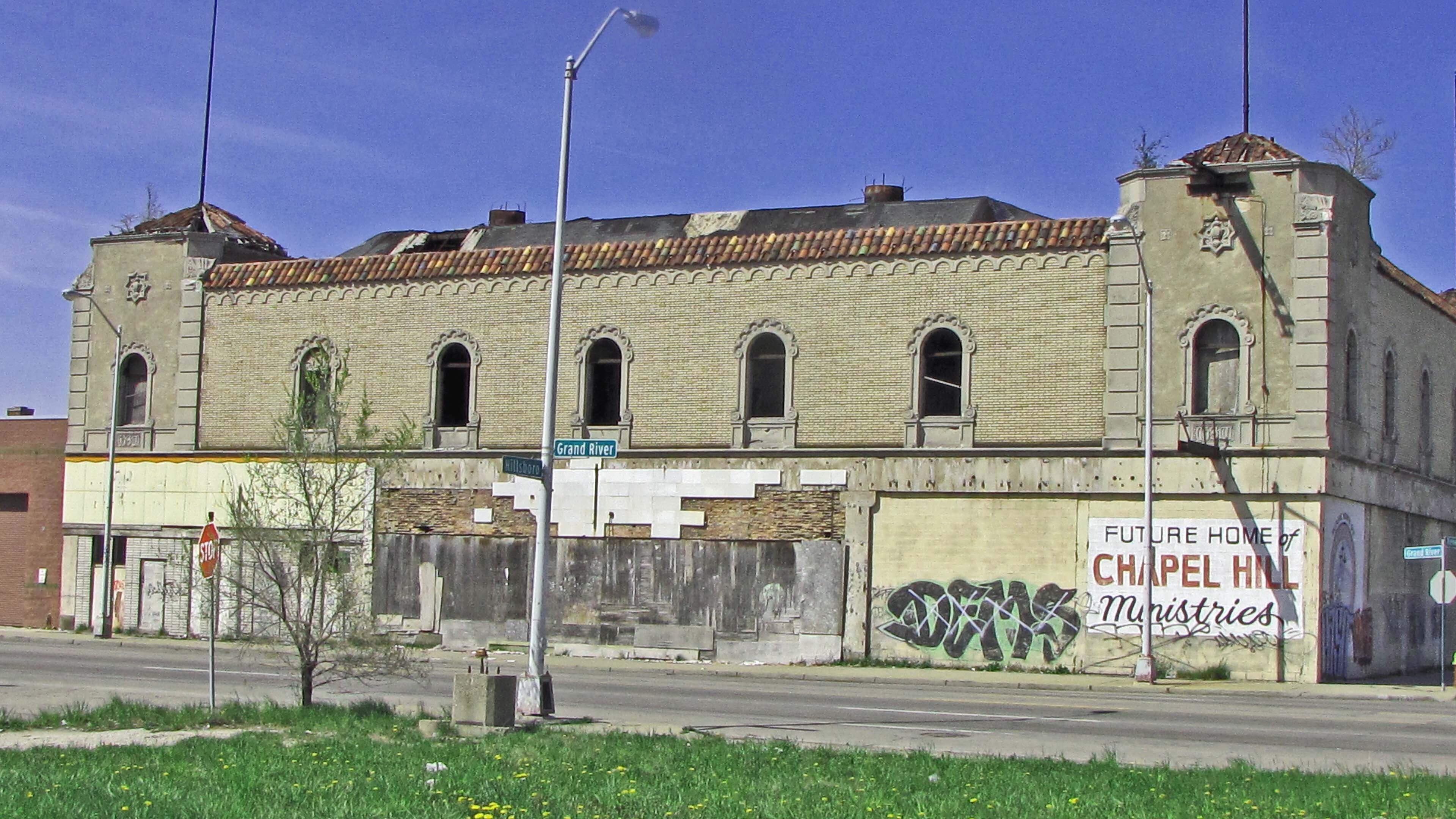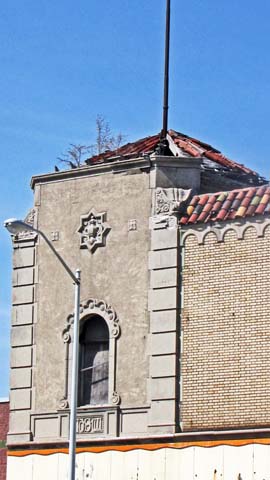

Individuals’ tastes in recreation change over time. In the 1920s, Detroit became a prosperous city. Thanks to the booming vehicle industry, a large middle class population lived on the West Side of Detroit. The nearby St. Theresa of Avila Church and Congregation B’Nai Moshe illustrate the financial resources of those who lived in these Motown neighborhoods. While they generously supported their religious congregations, they also wanted to enjoy themselves. In the 1920s, relatively few urban residents had their own cars so they looked for local activities such as movie theaters, or took street cars to downtown Detroit theaters and Navin Field where the Tigers played. People were also very much interested in music and ballroom dancing.
The building you see pictured above was one of about one-half dozen to dozen large ballrooms built in Detroit in the 1920s. The first floor was devoted to commercial space such as the retail stores you would find in any urban neighborhood. But there was a huge second story ballroom when dance bands would play. This facility was reputed to have one of the most appealing dance floors in the city. Times have changed and there are few, if any, venues that feature the large dance bands that were popular in the 1920s.
Detroit ballrooms, I infer, reached their peak popularity just before the Depression. In the 1930s, few people ha d much money for entertainment and, during the World War II years, almost all adults worked many hours in Detroit’s defense industries. There was an attempt to revive ballrooms after World War II but tastes in recreation and music had changed. People married at young ages and bore many children, giving rise to the Baby Boom and new lifestyles. Also, most all families had cars so they could leave their neighborhood to seek entertainment elsewhere. And by the 1950s, this area of Detroit began losing population to the suburbs.
d much money for entertainment and, during the World War II years, almost all adults worked many hours in Detroit’s defense industries. There was an attempt to revive ballrooms after World War II but tastes in recreation and music had changed. People married at young ages and bore many children, giving rise to the Baby Boom and new lifestyles. Also, most all families had cars so they could leave their neighborhood to seek entertainment elsewhere. And by the 1950s, this area of Detroit began losing population to the suburbs.
The Grande Ballroom did not fare well. Apparently, there was a brief and unsuccessful attempt to use it for an alcohol-free night club in the 1950s. It might have faded into oblivion but for the great efforts of Russ Gibbs. I believe that he taught, at some point, at the University of Michigan’s Dearborn campus but his passion was the innovative music that was developing in Detroit in the 1960s—not the Motown Music of Barry Gordy but the Detroit style Rock and Roll music we associate with Alice Cooper and Bob Seger.
Russ Gibb, visited San Francisco and was very much impressed by the success of the Fillmore Theater. He returned to Detroit and developed plans that eventually led to his ownership of the Grande Ballroom. He very successfully promoted innovative music at this location. This has been called psychedelic music, Detroit Rock and Roll or the music of the stoner counter-culture. For a few years, he was extremely successful so this ranks as one of many key sites in the long history of Detroit’s contribution to the world’s music.
The Led Zeppelin, Pink Floyd, the Grateful Dead, Janis Joplin, The Who, Chuck Berry, Howlin’ Wolf and the Velvet Underground performed here before enthusiastic audiences. For some time, the MC5 performed as the house band at the Grande Ballroom. Modern jazz was also featured here with performance by John Coltrane and Sun Ra. Many people who were in their late teen years or early twenties in the 1960s have vivid—if not necessarily accurate—memories of tremendous concerts held at the Grande Ballroom. Young people today would be extremely surprised to realize the tremendous quantities of non-prescription drugs consumed at these concerts. The pungent—and pleasant—smell of marijuana permeated the premises. You certainly did not have to smoke to inhale at places such as the Grande Ballroom. Observers note, at the time, that the crowds at this venue were overwhelming young white people from the suburbs.
The post-World War II life of the Grande Ballroom was a short one. Civil authorities gradually began to curtail the activities that occurred within and around such venues. Other venues also began to capitalize upon the popularity of Detroit Rock and Roll music. The regular use of the Grande Ballroom as a major concert scene ended in 1972. From time to time, a few concerts were scheduled after that, but its axis mundi status in the Detroit music scene came to an end. In 2006, a congregation, The Chapel Hill Ministries, announced plans to convert the impressive and historic ballroom into a church, but as of 2011, there was no evidence of any renovation.
The accomplished Detroit architect, Charles N. Agree, designed this structure. He also designed one of the leading ballrooms on the east side, Vanity Ballroom on East Jefferson not far from the Detroit-Grosse Pointe Shores boundary. Both of those impressive structures are still with us but, alas, both of them are dilapidated and unused. After his successful career as a music promoter, Russ Gibb spent, perhaps, two decades as a teacher in the high schools of Dearborn.
Architect: Charles N. Agree
Date of Completion: 1928
Architectural Style: Moorish Art Deco
Use in 2011: Abandoned building awaiting renovation
Website: http://www.thegrandeballroom.com/
History of the Grande Ballroom: Pages 65 to 74 in Lost Detroit: Stories Behind the Motor City’s Majestic Ruins by Dan Austin. (Charleston, S. C.: The History Press, 2010.)
History of Detroit Rock and Roll: Grit, Noise and Revolution: The Birth of Detroit Rock and Roll, by David A. Carson (Ann Arbor: University of Michigan Press, 2006)
Website for Russ Gibb: http://www.russgibbatrandom.com/
City of Detroit Designated Historic District: Not listed
State of Michigan Register of Historic Sites: Not listed
National Register of Historic Places: Not listed
Photograph: Ren Farley; May 9, 2011
Description Updated: December, 2011